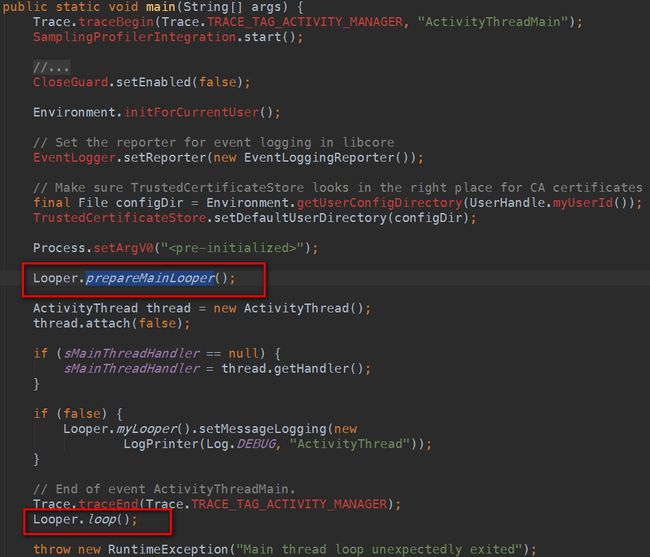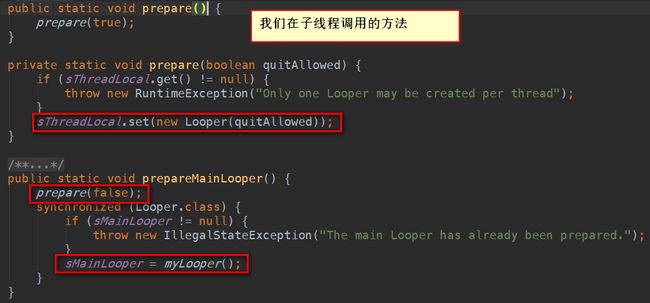日常使用
post()最终还是调用sendMessage方法
public final boolean post(Runnable r)
{
return sendMessageDelayed(getPostMessage(r), 0);
}
private static Message getPostMessage(Runnable r) {
Message m = Message.obtain();
m.callback = r;
return m;
}
而使用Callback接口只是为了让你不再重写Handler类而已,至于图片上,只是为了说明返回值的影响,一般使用了Callback之后就不会再重写Handler的handleMessage方法,那么返回值是false也没关系,因为Handler本身的handlemessage是空实现
在子线程
应该在Looper#loop()方法之后调用handler.getLooper().quitSafely();
如果在子线程new Handler ,假如没有调用looper.prepare(),就会抛出异常
if (mLooper == null) {
throw new RuntimeException(
"Can't create handler inside thread that has not called Looper.prepare()");
}
looper.prepare()方法就是创建一个Looper的对象
分析
ActivityThread#main
Loooer#prepareMainLooper
//Looper构造函数
private Looper(boolean quitAllowed) {
mQueue = new MessageQueue(quitAllowed);
mThread = Thread.currentThread();
}
//------
public static @Nullable Looper myLooper() {
return sThreadLocal.get();
}
//---在声明为成员变量的时候就已经赋值了
static final ThreadLocal sThreadLocal = new ThreadLocal();
ThreadLocal介绍
至此创建了一个Looper的实例,并且存放子啊ThreadLocal 中,并把这个Looper实例同时赋值给sMainLooper变量。而在Looper的构造函数中创建了MessageQueue实例,并把当前的线程保存下来
MessageQueue
/**
* Low-level class holding the list of messages to be dispatched by a
* {@link Looper}. Messages are not added directly to a MessageQueue,
* but rather through {@link Handler} objects associated with the Looper.
*
* You can retrieve the MessageQueue for the current thread with
* {@link Looper#myQueue() Looper.myQueue()}.
*/
MessageQueue中存放的是一个Message的链表,这个链表是给Looper对象分发用的。这个Message对象不是直接添加到MessageQueue,而是通过Handler对象
在MessageQueue中有个成员变量Message
Message
而在Message类中
// sometimes we store linked lists of these things
/*package*/ Message next;
那么这个链表就通过这样的方式形成了
Looper#loop()
回到ActivityThread#main中,最后调用了Looper#looper方法
在loop方法之后调用quitSafely或者quit方法,否则这个线程就会一直运行
一开始的的代码加上Thread Name 才运行
loop()方法是一个死循环,唯一退出的条件就是MessageQueue.next()返回null,而使MessageQueue.next()返回null,就必须调用Looper的quit方法,quit方法再调用MessageQueue的quit方法,继而MessageQueue的next方法才会返回null
MessageQueue#next()
- MessageQueue中的Message队列是按分发的时间排列的,比如说使用handler 调用sendMessageDelay延时发送为15s ,一个为16s,那么延时16s的会排在15s的后面
- Message.target 在Message 加入到MessageQueue中的时候就被赋值成发送它的Handler实例
- IdleHandler
/**
* Callback interface for discovering when a thread is going to block
* waiting for more messages.
*/
public static interface IdleHandler {
/**
* Called when the message queue has run out of messages and will now
* wait for more. Return true to keep your idle handler active, false
* to have it removed. This may be called if there are still messages
* pending in the queue, but they are all scheduled to be dispatched
* after the current time.
*/
boolean queueIdle();
}
当我们的主线程空闲的时候就会调用存在MessageQueue中list的IdleHandler对象,我们常说的GC也是通过IdlerHandler来实现的(部分)
demo
Looper.myQueue().addIdleHandler(new MessageQueue.IdleHandler() {
@Override
public boolean queueIdle() {
Toast.makeText(HandlerActivity.this, "idle handler", Toast.LENGTH_SHORT).show();
return true;
}
});
queueIdle()方法返回true就代表这个IdleHandler对象一直存在于MessageQueue的list中,主线程一有空就会去调用里面的IdleMessage的queueIdle方法,而false就代表执行一次就被list移除掉
上面的代码假设你不操作手机屏幕使主线程处于空闲中,那么回一直会有Toast弹出
- 至于最后的pendingIdleHandlerCount = 0;导致了最后那段for循环不再被执行,那么IdleHandler在哪执行呢?个人怀疑是底层的c那边吧,不确定。如有知道的大佬,麻烦说说,谢谢
Handler.dispatchMessage(msg)###
拿到Message之后,回到Looper的loop方法中,就会调用我们的Handler.dispatchMessage方法
public void dispatchMessage(Message msg) {
if (msg.callback != null) {
handleCallback(msg);
} else {
if (mCallback != null) {
if (mCallback.handleMessage(msg)) {
return;
}
}
handleMessage(msg);
}
}
msg.callback 就是我们通过handler的post方法中的参数Runnable对象,而handleCallback(msg);就会执行Runnable对象中的run方法
而mCallback就是Handler(new Handler.Callback()),这个里面的Callback就是它
handleMessage(msg);最后这个就是我们Handler方法的handleMessage方法
msg.recycleUnchecked();
loop循环中最后一句就是回收Message
/**
* Recycles a Message that may be in-use.
* Used internally by the MessageQueue and Looper when disposing of queued Messages.
*/
void recycleUnchecked() {
// Mark the message as in use while it remains in the recycled object pool.
// Clear out all other details.
flags = FLAG_IN_USE;
what = 0;
arg1 = 0;
arg2 = 0;
obj = null;
replyTo = null;
sendingUid = -1;
when = 0;
target = null;
callback = null;
data = null;
synchronized (sPoolSync) {
if (sPoolSize < MAX_POOL_SIZE) {//MAX_POOL_SIZE =50
next = sPool; // next 为Message 成员变量
sPool = this;//sPool为Message静态变量
sPoolSize++;
}
}
}
形成链表,保存一些空闲的Message
我们使用message的obtain()方法就是从sPool中获得Message实例
Handler.sendMessage
Handler.sendMessage方法最终都会调用下面的方法将message加入到MessageQueue中
private boolean enqueueMessage(MessageQueue queue, Message msg, long uptimeMillis) {
msg.target = this;//上面说过target就是发送这个mes的handler对象
if (mAsynchronous) {
msg.setAsynchronous(true);
}
return queue.enqueueMessage(msg, uptimeMillis);
}
Looper#enqueueMessage
最后
本来想画一张流程图的,但是怎么想也不满意,就简单写个流程吧
- 获得Message(new 或者obtain)
- 通过handler加入到MessageQueue中
- Looper通过MessageQueue获得Message
- Looper将获得的Message交给发送Message的Handler处理
- Handler处理完成之后,Looper将Message放到Message池中
上面没有提及到Looper是死循环,若加上可能就是写3--5 是一个循环,但是并不好感觉
上面的分析流程全是自己分析,有点乱
什么都最好自己亲自做一遍,才更好,也会发现一些新的东西
比如IdleHandler,GC啥的








